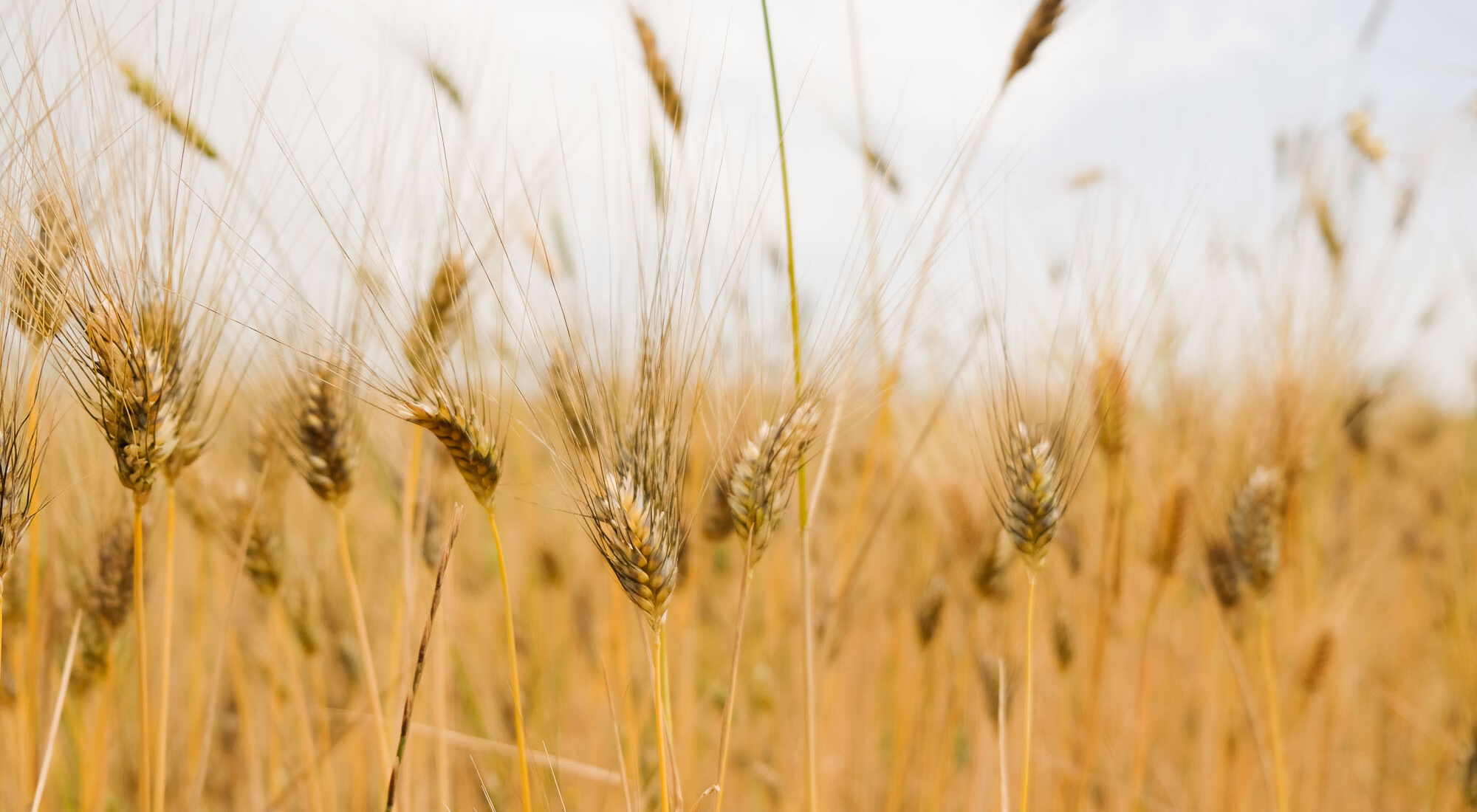WHEAT IN AKKAR
TEXT: JENNY GUSTAFSSON
PHOTOS: JENNY GUSTAFSSON
RESEARCH: ANGELA SAADE, YARA WARD
EDITS: NISREEN KAJ
Making freekeh with Alya Hazim and her family
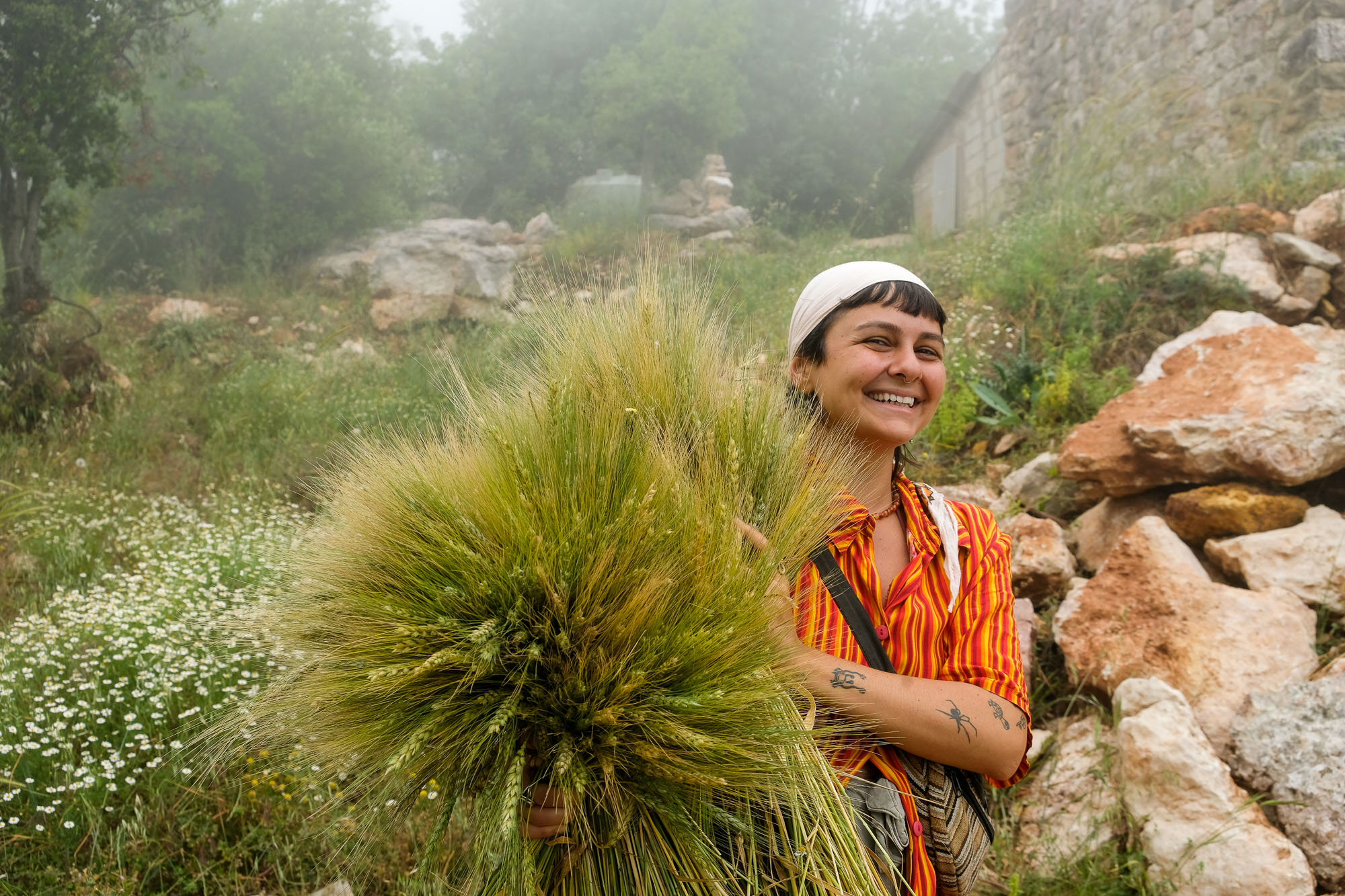
Alya Hazim holds up an armful of heavy bouquets of wheat about to be roasted over open fires and become freekeh
In the mountains of Akkar in northern Lebanon, a winding road cuts through the small town of Hrar. Next to a tiny bakery, a gravel road veers to the right, eventually ending among small, overgrown fields. Alya Hazim, wearing a scarf tied around her head to shield herself from the sun, crosses the road. Nova, her dog, traces her footsteps. It is a late spring morning and Alya has just arrived from Beirut.
“I like to be a bridge between the mountain world and the city world. I come here and bring what is needed back to the city,” she says.
She sets her sight on a big flat stone beneath the shade of a tree, large enough to sit on comfortably. A few piles of wheat with long stalks rest on the ground, ready in anticipation of her arrival. Wheat is what brought Alya to Hrar, her mother’s village, at this particular moment; it is the right time of the year to harvest green wheat and roast it to produce freekeh, a much-loved staple in the Lebanese pantry.
Nova lies down on the ground while Alya, seated on the stone, picks up strand after strand of wheat from the pile, gathering them into sturdy bouquets.
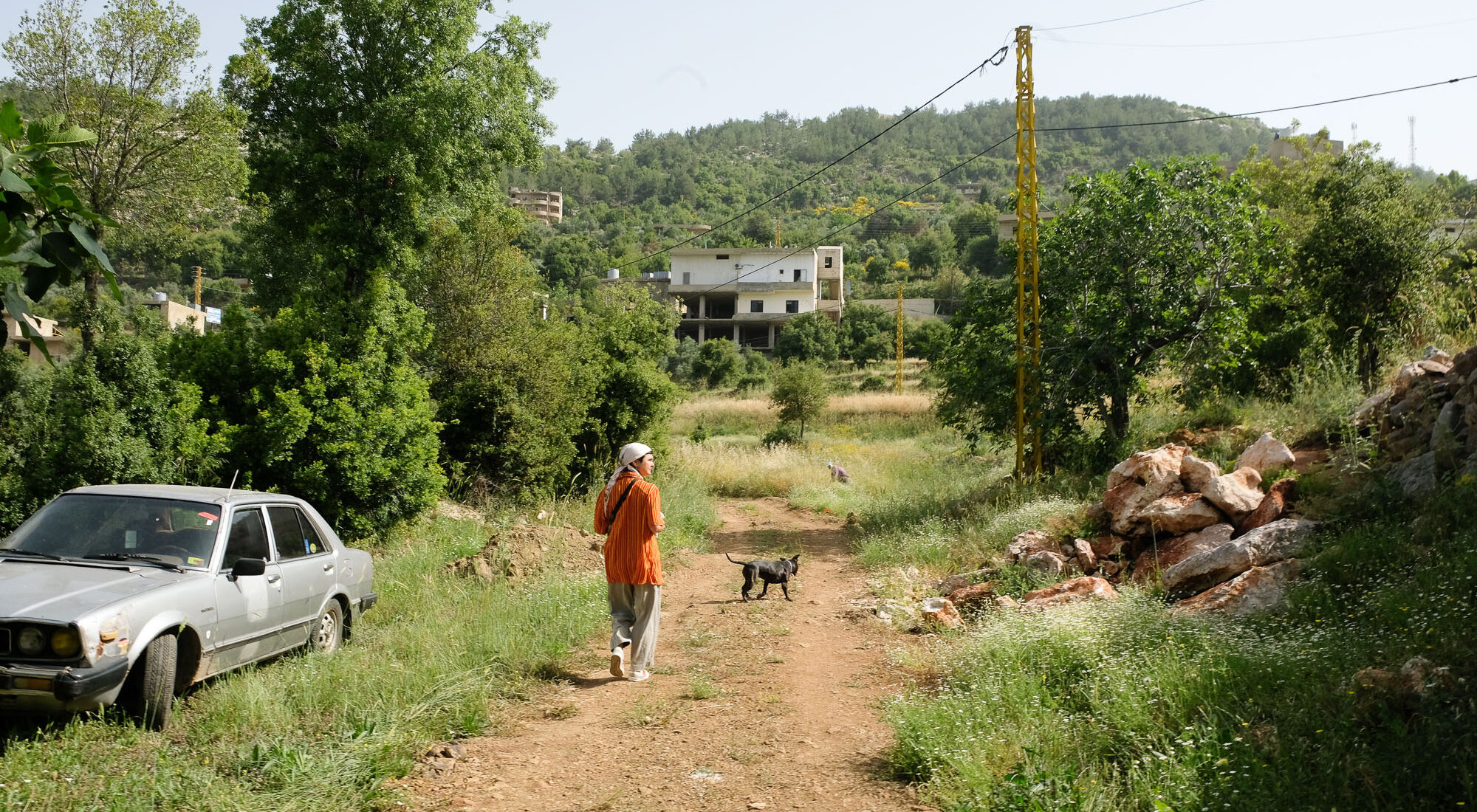
“This is the most time-consuming part of making freekeh, but it’s also the most rewarding,” she says.
Each time she picks up a strand, she examines it closely to make sure no ripe heads end up in the bouquets. Freekeh must be made solely from green wheat, to attain its distinct chewy texture and nutty flavor.
A man with a blue cap walks up to Alya, his arms full of wheat. He drops them onto the pile on the ground, then goes back to gather more. The man, Khaled Baarini, works with farmers in Hrar when they need help during harvest time.
“Look at this bounty. This is God’s beauty,” Khaled says as he walks among the tall, sand-colored plants.
The wheat growing on the slopes of Hrar has deep historical roots. The Fertile Crescent is believed to be the center of origin of the Triticeae family of wild grasses, to which wheat, rye, and barley belong. Modern wheat’s earliest ancestors – einkorn, emmer, and spelt – can still be found growing here in the wild.
The region is also home to history’s first farmers. Scientists believe that wheat was planted for the very first time in the Karacadag Mountains in southeastern Turkey, over 10,000 years ago. With those planted grains, agriculture as we know it began.
However, wheat had been consumed by humans for a long time prior to that period. The earliest known evidence of breadmaking was found in the Black Desert in Jordan, at a 14,000-year-old archaeological site. The ancient Egyptians were also early bread makers – when they did not use the grains to brew beer.
Different varieties of wheat then spread with the movement of humans, along the Silk Road and on maritime routes. Early farmers carried what Nature magazine calls a “Neolithic toolkit” with crops, animals, and farming tools. As they journeyed to Europe, Africa, and the Indian subcontinent, farmers planted wheat in these new locations. It adapted – as wheat tends to do – to different conditions and developed great genetic diversity.
“Humans just need to start planting and harvesting … as soon as they do that, the plants respond,” archaeologist Bruce D. Smith said in a Los Angeles Times article about ancient wheat.
Alya searches for wheat with green kernels, to be tied into bouquets
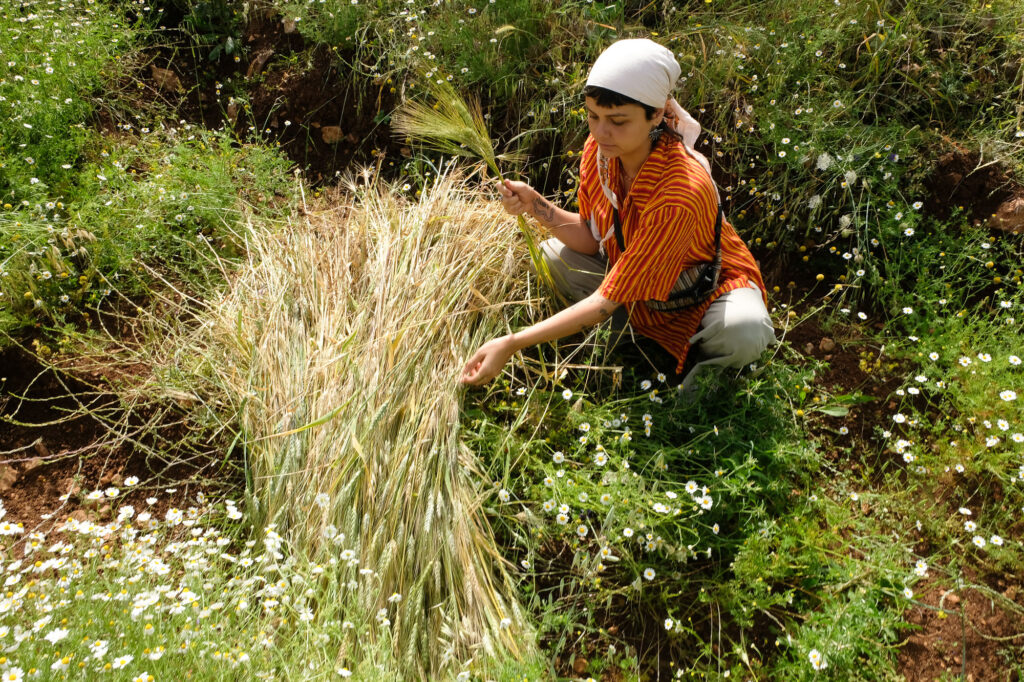
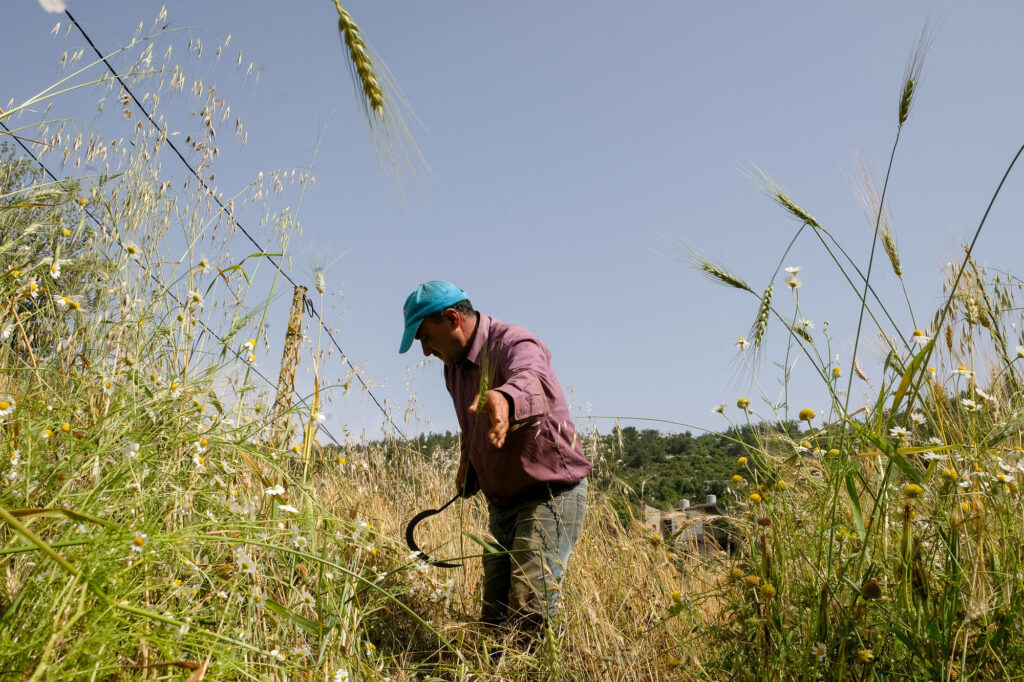
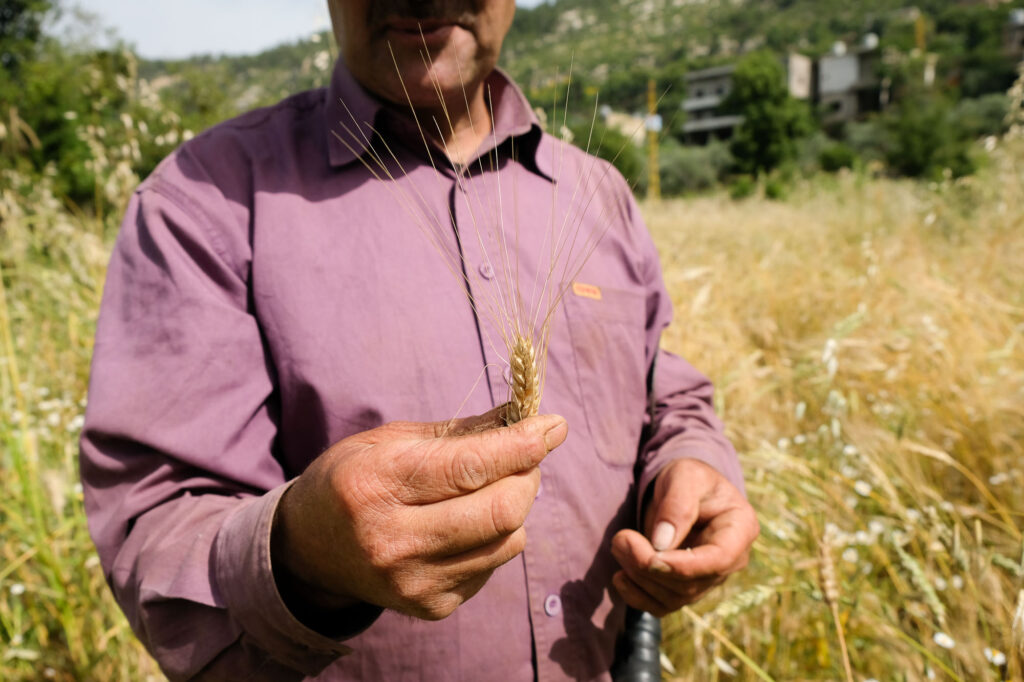
Khaled Baarini, also from Hrar, and with a long experience of planting and harvesting crops, joins Alya and her family in the fields when it's harvest time
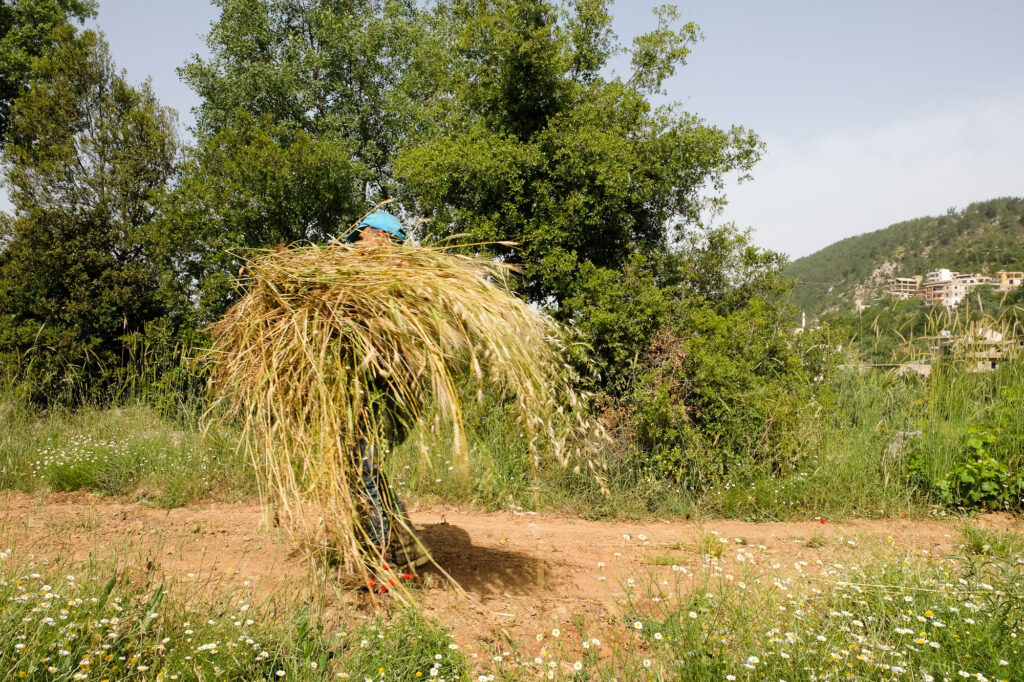
Wheat has surely meant more to humans than any other grain. It is rich in proteins and carbohydrates, tolerates harsh conditions, and can be stored or traded easily. It is now more widely produced than any other cereal, and provides around 20 percent of the world’s daily calories.
In Lebanese towns and villages, wheat was always essential to life. Bread and bulgur are important staples and continue to form part of most meals. In the early and mid-1900s, when most Lebanese lived in the countryside, most of the wheat was locally produced. Today, almost everything is imported.
“We import 550,000 tons of wheat every year, or 90 percent of what we consume” Serge Harfouche, a member of the farm and seed library Buzuruna Juzuruna, says.
He sits in a big circle of people in the midst of the group’s wheat plantations in the Bekaa Valley. It is a sunny day in June and they are hosting a festival for ancient cereals, where people can meet bakers and farmers. Loafs and flatbreads made from heirloom wheat are laid out on a table, sand-colored fields stretch into the distance.
Buzuruna Juzuruna grows 44 types of wheat on this land, all planted from ancient varieties. In history, the Bekaa Valley functioned as the wheat silos of the Roman Empire. Now, few people grow wheat here.
“Why did we plant this wheat? We wanted to show people that growing our own wheat is not a dream, it can be reality,” Serge says to the audience.
Many agree with him. But the owner of a large bakery argues that it is not that simple. He needs to buy wheat in large quantities, he says, with the exact same properties each time. Local or heirloom wheat cannot meet those demands.
This issue goes back to the middle of the last century, when a significant shift occurred in global wheat production. A series of agricultural innovations known as the Green Revolution made it possible to grow much larger quantities than before. It came as a response to global population growth, and changed the nature of agriculture all over the world.
New varieties of wheat were introduced that could respond better to irrigation and provide higher yields. But they required the use of chemical fertilizers and pesticides, as the natural resistance to pests and disease found in older wheat had been modified.
The height of ancient wheat, for instance, was reduced. Old varieties would tower up to 170 centimeters, enabling them to outcompete weeds. But they could not be sprayed with fertilizers, as this would cause them to topple over. Scientists, therefore, brought in dwarfing genes, in particular from a Japanese variety called Norin 10, to create a new cohort of short wheat. It quickly spread across the world – today, over 70 percent of our wheat has Norin 10 in their genomes.

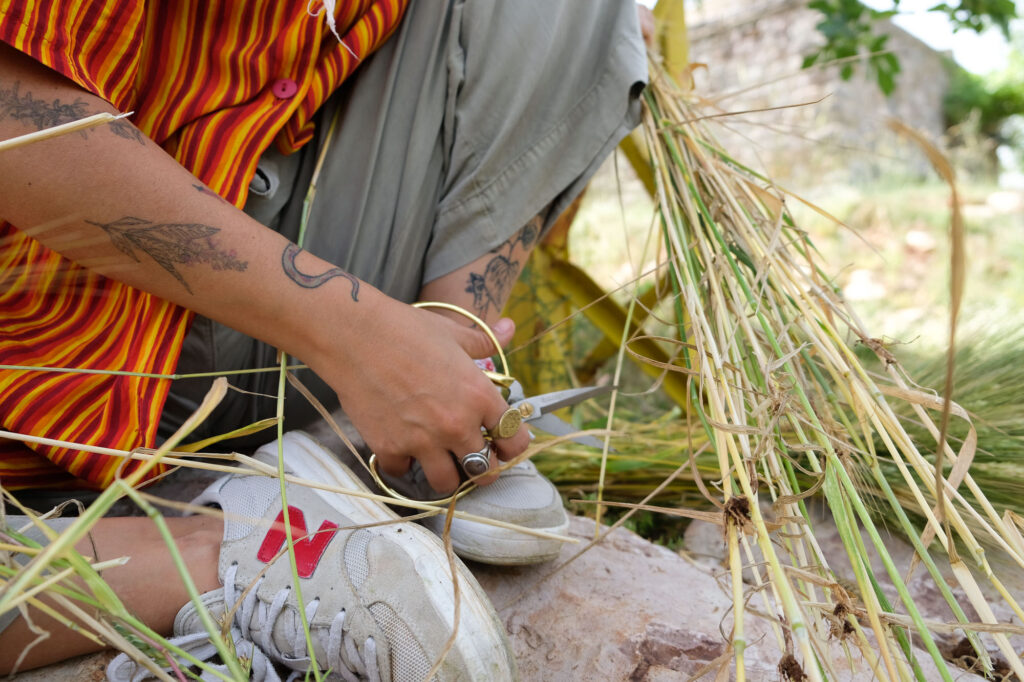

Global wheat production went up dramatically in those years. From 700 million tons per year in the 1950s to 1.9 billion tons every year at the end of the century. But it also meant that countless local varieties of wheat disappeared from farmers’ lands – and from people’s plates.
India saw perhaps the biggest change of all. It went from being a major importer to taking second place among the world’s top exporters of wheat. This came with a price, though. Some of the subcontinent’s best farmland was destroyed, rivers and lakes were polluted, and biodiversity decreased.
All wheat planted by Buzuruna Juzuruna in the Bekaa Valley are heritage varieties, as are the plants growing on Alya and her mother’s land in Akkar.
By now, the pile of wheat bundles by Alya’s feet has grown. Her mother, Hasna Ali, and a family member, Mal Al Hassan, have joined. Hasna takes a seat on the ground, stretching out her legs amidst the heaps of wheat.
The family grows two different kinds, both local varieties. The small fields where they are working today are filled with biyadi, which is good for making freekeh, bulgur, and amhiyye, a kind of porridge made from peeled wheat.
“People in the village say, ‘if you didn’t eat biyadi, you didn’t eat at all’,” Hasna says, as she picks up – and quickly discards – a strand of wheat that is too ripe.
Like many others in the mountains, the family has a piece of land in the jurd, a semi-arid area at a high altitude, some distance from the village. There, they grow salamouni.
“It is a very old grain and doesn’t give very much. It is the only variety that can survive in the jurd,” Alya says.
“That’s why it is called salamouni; it comes from ‘selem min el telej,’ which means not harmed by the snow.”
Mal, seated next to Alya, takes a piece of string to tie around the bouquet in her hand.
“In the past, we used to braid the wheat. We didn’t have string back then,” she says.
At that time, the village used to work together during the harvest. In the evenings, they would gather and sing. People would exchange products, like bulgur and yoghurt needed to make kishk, a fermented wheat and dairy product.
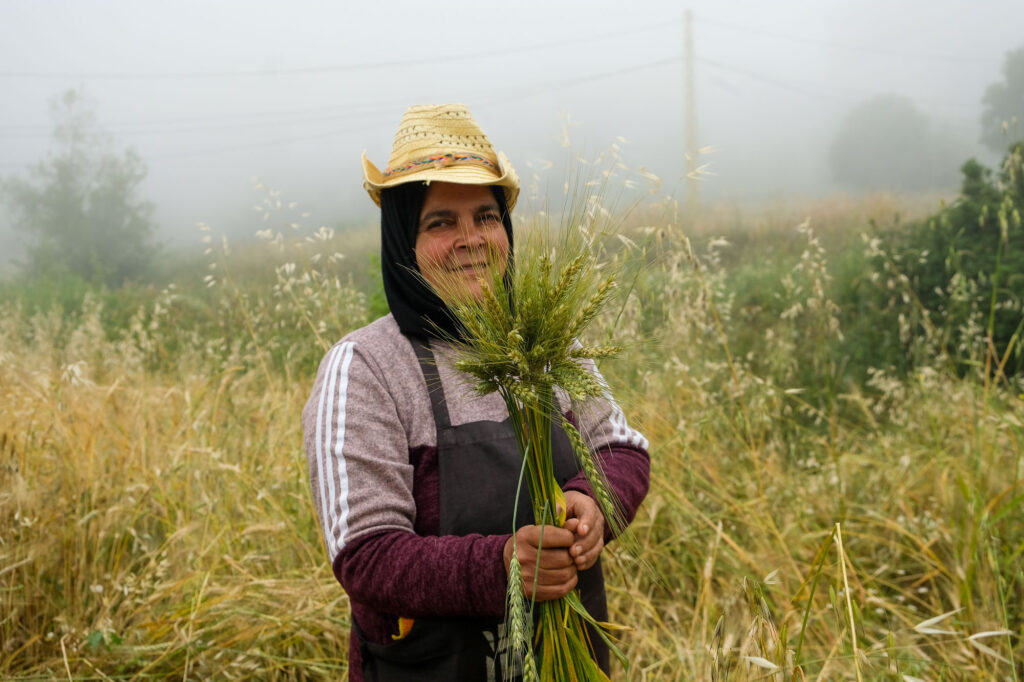
Mal al Hassan, a relative of Alya's, has made freekeh countless of times during her life
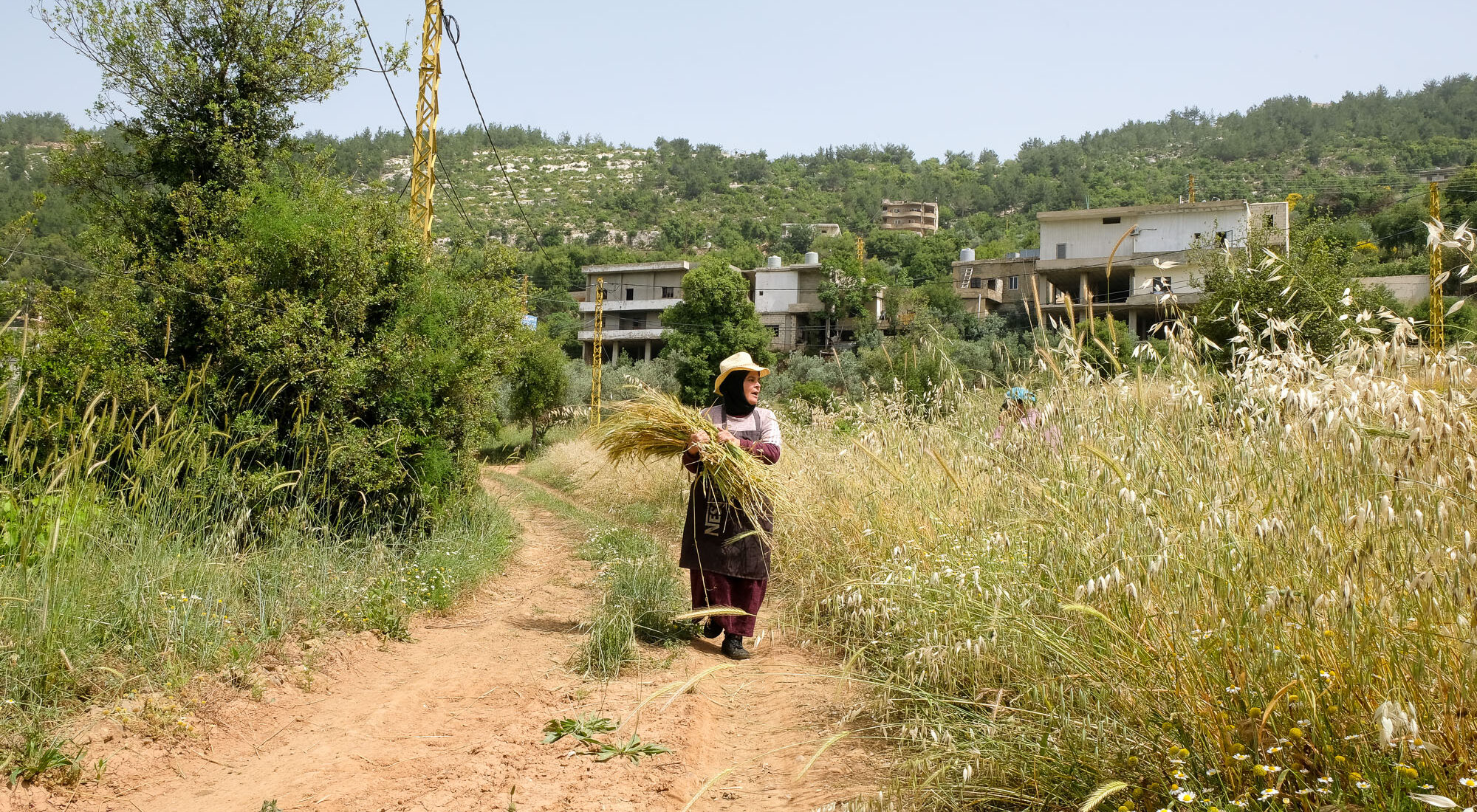
“Women and girls worked the hardest. They were in charge of the harvest, while men would do the planting,” Hasna says.
The word for female harvester, “hassade,” even became the name of the modern harvesting machine.
“The life of farmers is nice when you speak about memories, but it was hard in reality,” Hasna says.
Today, she is one of few people growing wheat in Hrar, and perhaps the only person making her own freekeh. In the years following the Green Revolution, Lebanon – like many other places – saw a shift from ancestral to commercial wheat. Hasna remembers how the government came and planted new varieties in Hrar.
“But people didn’t like the taste of the wheat. And since it was short, it didn’t give a lot of hay, which people needed for their workers,” she says.
It was common at the time for farmers to give all hay from the harvest as payment to people working with them, who would then use it to feed their animals.
Today, some two-thirds of Lebanon’s agricultural land is owned by the top 10 percent of landowners, many of whom are linked to political figures. An article published by the Carnegie Middle East Center calls this an “oligopoly-like grip” on the market. Add to that the country’s agricultural policies, which for the longest time have been geared towards cash crops and export. It all dates back to the beginning of Lebanon as a modern state, and the 1915-1918 famine that followed a shift from local food to export crops like silk.
Today, over a century later, the food and nutrition situation is again looking bleak. Around 2 million people in Lebanon now face food insecurity, mainly as a consequence of the financial crisis, but also exacerbated by inequality, exploitation, and environmental issues. The price of wheat has surged multiple times since the crisis began in 2019. The vulnerability of the situation became evident with the conflict in Ukraine, where Lebanon gets 80.4 percent of its imported wheat from (add to that 15.5 percent from Russia).
Frank Oekotter, a professor of environmental humanities, called the global farming regime “a bad relationship” in an episode of the BBC podcast The Food Chain. “But unlike a bad relationship, you can’t just leave it and look for something else,” he said.
In Akkar, Alya heads to the small bakery at the junction to pick up manouche for breakfast. She had passed by earlier that morning with her mother’s zaatar and olive oil, so the baker could spread the mix on the dough before baking.
When she returns to the field, they all take a break from the wheat and start chatting. Hasna reminisces about meeting and getting married to Alya’s father. It was at this time of the year, she says, because the wheat had the same color.
“We have a saying that goes, ‘when someone gets married to a person from another village, it is like eating wheat coming from across the sea’,” she says.
The idea is that local wheat is always better than imported grains, coming from afar.

Hasna Ali, Alya's mother, is known in Hrar for her knowledge in making freekeh
Wheat has always carried symbolic meaning. It represents fertility, abundance, and bounty, and is often associated with women, due to both’s ability to give life and nurture society. The goddess of agriculture in Roman and Greek mythology, known as Ceres in the former and Demeter in the latter, was typically depicted with a sheaf of wheat in her hand or a crown of wheat on her head.
Several countries have incorporated wheat on their coats of arms, including China, Bolivia, South Africa, and many former Soviet nations. Wheat occupied a central place in Soviet aesthetics, and appeared on many mosaics and murals. The Ukrainian flag, with its blue top stripe and golden yellow bottom, represents the sky over endless fields of wheat. Afghanistan also had wheat on several flags in use until the Taliban takeovers.
Several English words trace their etymology to wheat or bread, like the word “lord,” which stems from Old English words for loaf and ward and literally means “bread keeper,” or “companion,” which derives from the Latin word for bread.
Socrates is often quoted saying something along the lines of, “No man qualifies as a statesman who is entirely ignorant on the problems of wheat.”
In many countries, including Lebanon, wheat was also a means for paying taxes. Lebanese farmers were required to give part of their harvest to wealthy and influential families known as bakawat (or beik in singular), who had been given local authority during the dissolution of the Ottoman Empire. They imposed a tax called aasher, from the Arabic word for ten, which obliged families to pay in land or animals if they did not have money. That way, many feudal families gained control over farmers’ lands.
“My father didn’t want to be under the power of the bakawet, so he bought his own land back to get full ownership of the harvest,” Hasna says.
Farming families were also asked to pay taxes in wheat and flour, or in freekeh, which was common. With all the work involved in making freekeh, they produced it only to give it away to local rulers.

“That’s why people in the village call Hasna Imm Abboud, the name of one of the wives of the old beik. Because she is known for making freekeh,” Mal says with a smile.
The sun above their heads has reached its highest point, and they are done with the first part of the freekeh. The only wheat left on the ground has pale, cream-colored heads, too ripe to make it into any of the bouquets. Alya grabs a handful of bunches and starts carrying them towards the car.
“I remember as a kid there would be bouquets I couldn’t carry. They look small but they get heavy,” she says.
Soon, all the wheat is in the trunk of the car. They drive back up the small road, reaching Hasna’s house within minutes. Immediately, she starts preparing for the final step: roasting the wheat over open fires.
Khaled collects dry leaves and sticks from the garden, and gathers them in two small piles. Mal prepares a third pile and places a large cauldron of water on top. Hasna sets the piles on fire, while Alya goes to get the bouquets from the car.
“Everything I know about the land I learned from my mother, from what she has been doing throughout the years. It’s about respecting what was passed down to me,” she says.
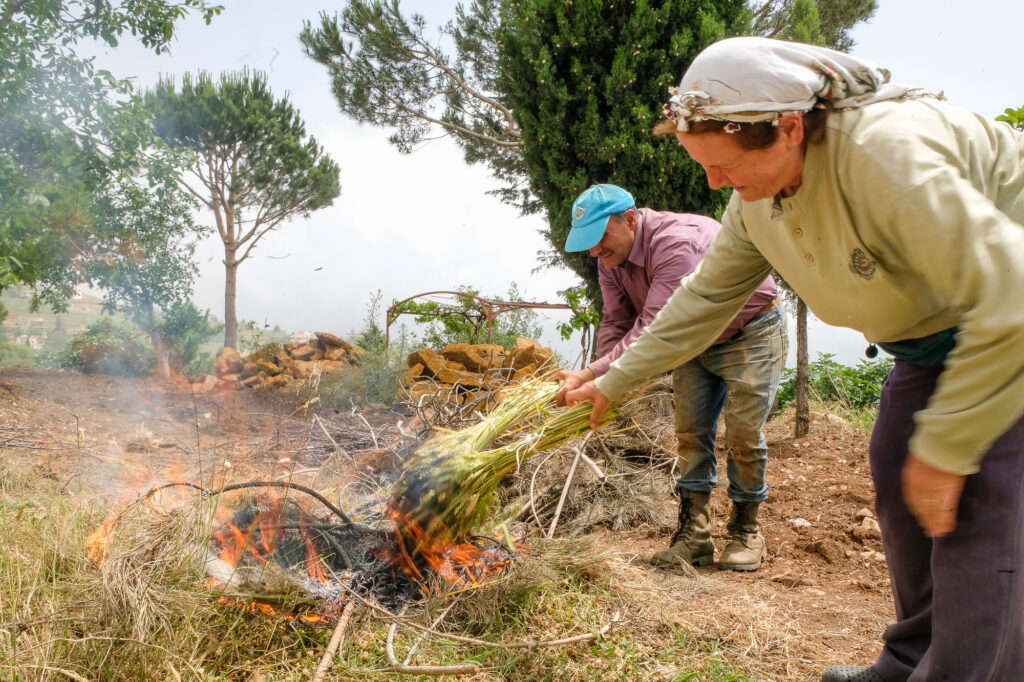
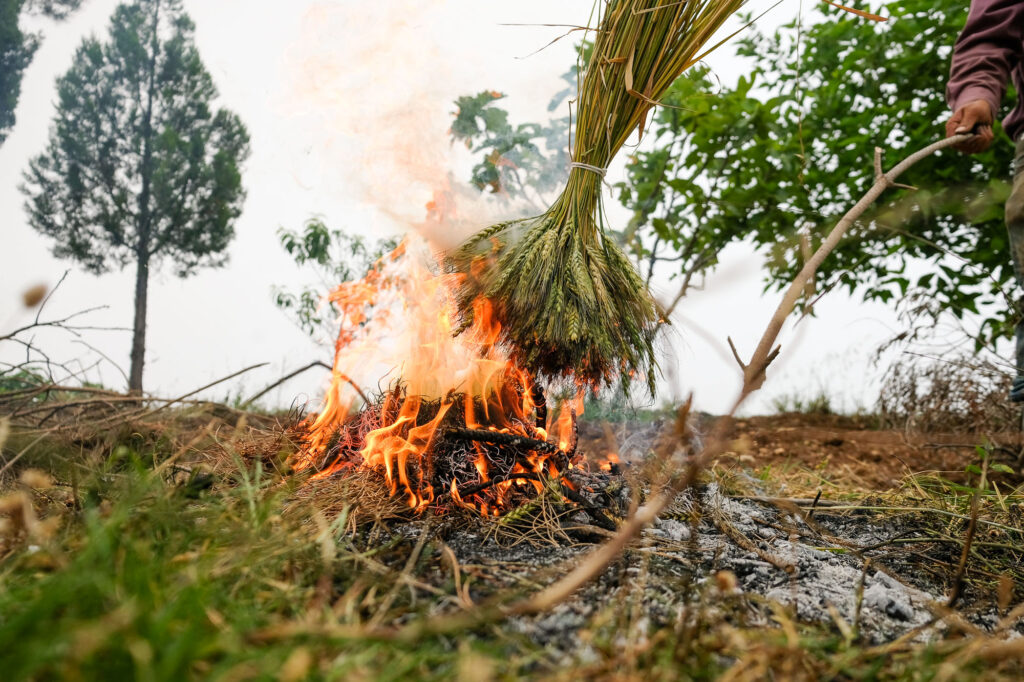
When all the wheat has been prepared and tied together, it is time to roast the kernels over open fires. This is how freekeh gets its characteristic texture and flavor.
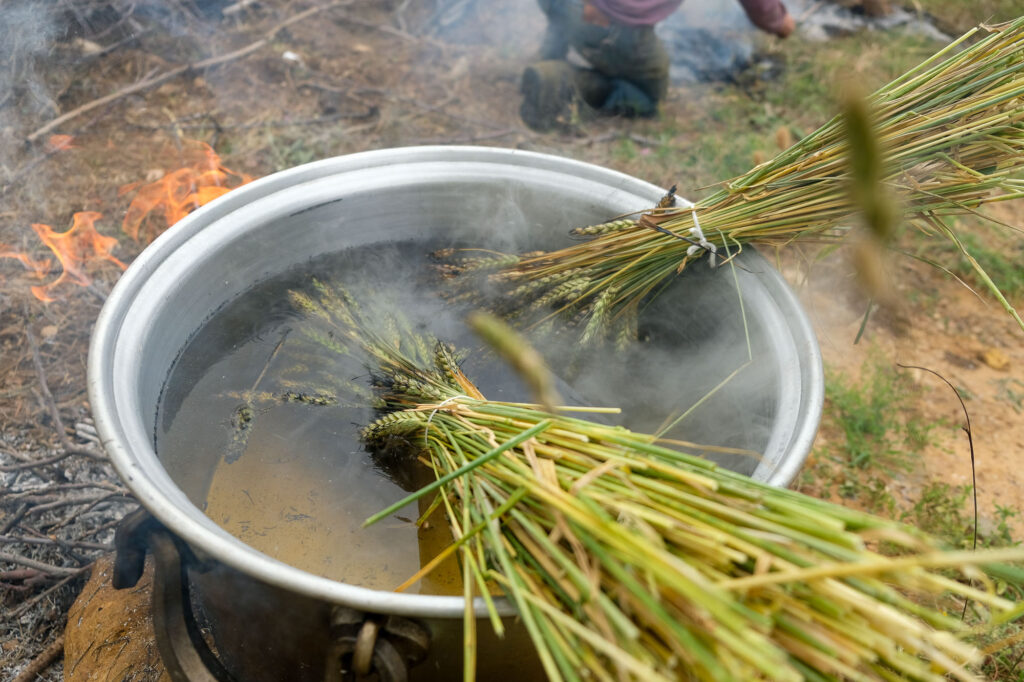
The roasting process serves a double purpose: to dry the kernels and to give them a thick, smokey flavor.
The story goes that freekeh began as a lucky mistake. Some time in history, a village in the Jabal Aamel region in southern Lebanon came under enemy attack, and all crops caught fire. After the siege was over, the villagers managed to save the wheat by rubbing away the blackened chaff – and found delicious roasted kernels inside.
Today, freekeh is eaten in the entire surrounding region.
Egyptians use it to stuff pigeons or chicken, and eat it with fish along the coast. In Jordan and Palestine, freekeh is popular in soups such as shurbat al farik, made with onions and meat. Lebanese often serve it on plates generously topped with chicken and almonds or other nuts. It is mainly associated with the south, where the village of Chamaa is known for making particularly good freekeh.
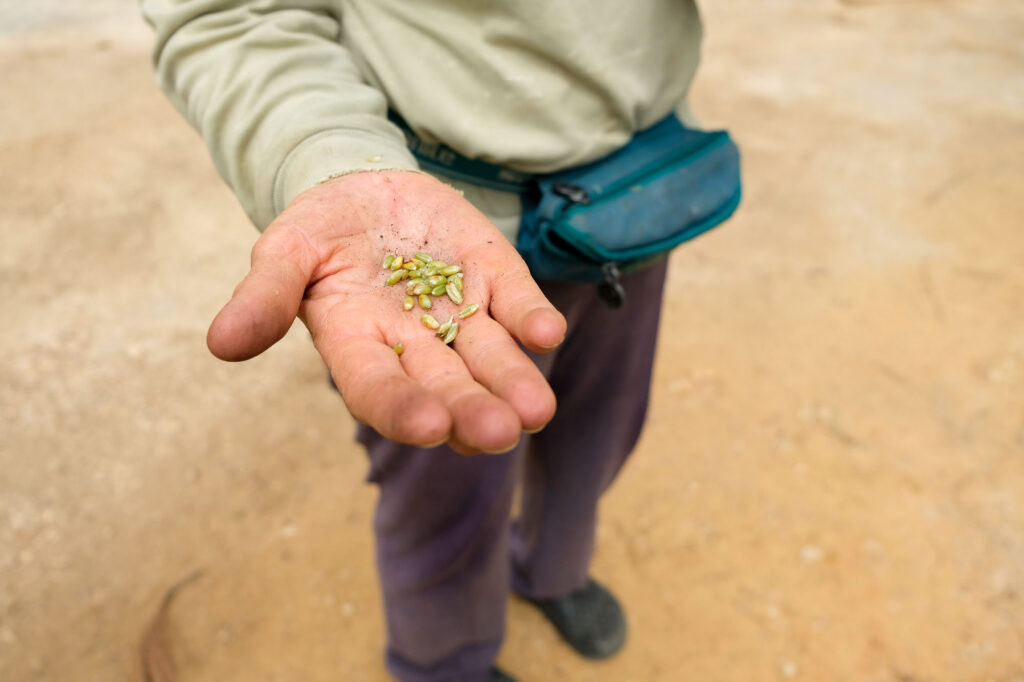
Hasna Ali, Alya's mother, shows the result of the roasting process: delicate kernels of burnt freekeh
In Hasna’s garden, the group roasts the wheat by sticking the bouquets directly into the fire. Each bundle is carefully turned around, so that no kernels are left untouched. Finally, they are placed in the cauldron to parboil quickly.
The history of freekeh goes far back. Roasted grains appear several times in the Old Testament, including among the foods David carried when he met Goliath, and as a love offering gifted by Boaz to Ruth. A cookbook from 13th century Baghdad has a recipe for “farikiyya,” a dish with grains and meat cooked in oil, water, and cinnamon bark.
In recent years, freekeh has gained popularity far beyond the Middle East. It has been called a super food due to its great nutritional value: it is rich in probiotics and antioxidants, as well as calcium, zinc, and iron. But it was only after Oprah mentioned it on her show that it came to be known as “the new quinoa” – or, as an article in The Independent stated, “Le freekeh, c’est chic.”
“I like to do freekeh because it is our heritage. I was raised with it. And it is satisfying to get food from your own land,” Hasna says.
She has taken a seat on a low concrete wall next to an old olive tree in the garden. She takes a straw from one of the bouquets and peels it, allowing the roasted kernels to land in her hand. Then, she starts rubbing them to remove the chaffs. This is where the name freekeh comes from: the verb “faraka” means rubbing.
“This is how people used to eat the seeds in the past, without preparing them. They didn’t have any mills at the time,” she says and puts a few kernels in her mouth.
Today, people cook freekeh before eating it. But first, as a final step after roasting, the grains are left to dry for about a month and a half.
Alya and her mother have enough freekeh for their own consumption, and enough to give away to members of the family as well.
“It gives it a different value,” Hasna says.
“It is about generosity, and there is so much abundance when you can give people from your own land.”
